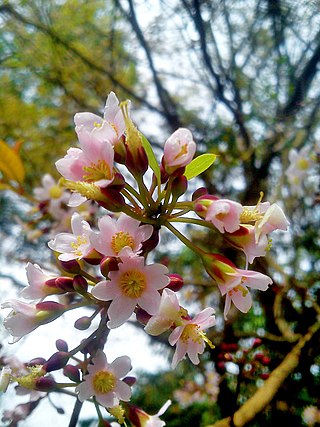Top Qs
Timeline
Chat
Perspective
Cratoxylum formosum
Species of tree From Wikipedia, the free encyclopedia
Remove ads
Cratoxylum formosum is a species of flowering plant in the family Hypericaceae. Its commercial name in timber production is "mampat".[3] The trees reach to 35 metres (115 ft) tall, though they rarely achieve the size required for timber exploitation.[3]
Remove ads
Remove ads
Description
The leaves are 5–9 centimetres (2.0–3.5 in) long, and are arranged on the stem such that they overlap one another. They are elliptic, glabrous (lacking hairs), and have a papery texture. The flower clusters (inflorescences) are cymes that are shaped somewhat like short racemes. The flowers are white or pink, with sepals a quarter of the length of the petals, which have a rounded base.[4]
Taxonomy
The species was previously placed in the defunct genus Elodes under the name Elodes formosa.[1] The Catalogue of Life lists two subspecies, C. formosum subsp. formosum and C. formosum subsp. pruniflorum (Kurz) Gogelein. The two are differentiated by the nominate subspecies being totally glabrous, with leaves that are elliptic to oblong, rarely lanceolate and the anther connective not being glandular.[5]
Remove ads
Distribution and habitat
Cratoxylum formosum is a tropical plant found in the Andaman Islands, Brunei, Burma, Cambodia, China, Indonesia, Laos, Malaysia, the Philippines, Singapore, Thailand, and Vietnam.[2] The trees bloom during the dry period in seasonal tropical climates. They inhabit primary and secondary forests at altitudes from 0–600 m, with the upper limit to 1200 m, on slopes, river margins and swamps in sandy to clayey soils.[5]
Conservation
Cratoxylum formosum is listed as least concern by the International Union for the Conservation of Nature,[1] but it is considered to be rare in Singapore.[citation needed] It has a widespread distribution and does not face any major threats,[1] though it is used in Laos for the production of charcoal.[6]
Gallery
- Cratoxylum formosum in bloom
- Fruit
- Drawing of the species (1880 to 1883)
References
Wikiwand - on
Seamless Wikipedia browsing. On steroids.
Remove ads





